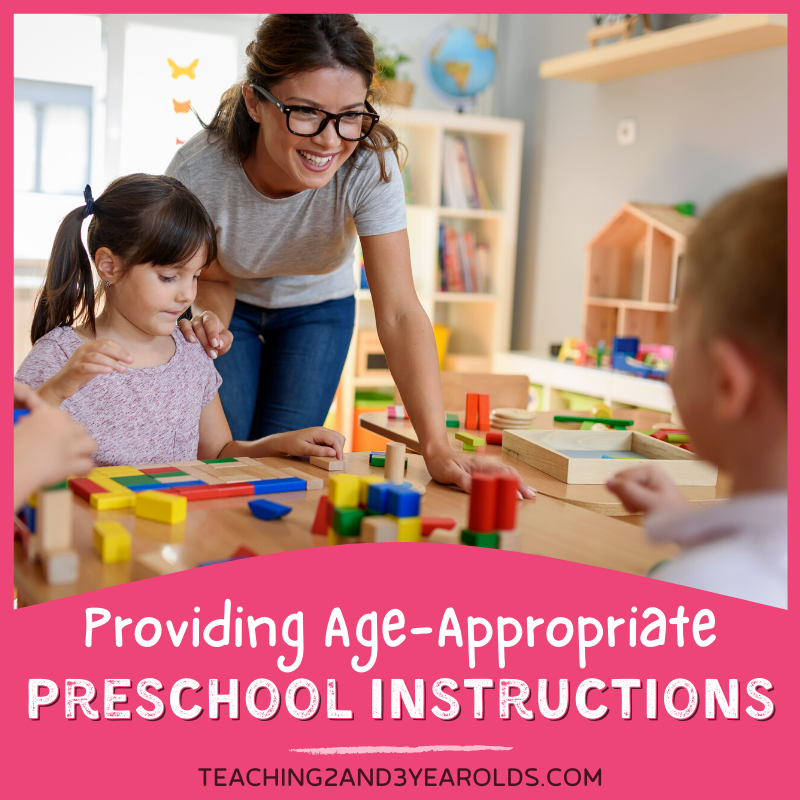Last Updated on September 15, 2025 by Sheryl Cooper
Inside: Read about how to provide age-appropriate preschool instructional strategies effectively, including tips and activity examples.
Through their various phases of development, children grow their capacity for comprehending instructions.
Naturally, a three-year-old will be able to follow instructions that a two-year-old cannot.
From 1 to 2 years of age, children are able to follow one step instructions at one time. This includes singular actions such as “throw the ball”.
As children grow closer to late 2 to 3 years old, they are typically able to follow two step instructions at once such as “throw the ball, then run to me”.
Later into the third year, children can begin to follow three steps at a time. It’s important as a parent and as an educator to understand the level of instruction that a child can handle, especially in a mixed age classroom.
Below are examples of activities that call for one and two step instructions, as well as some tips for helping your instructions run smoothly.

How to Provide Age-Appropriate Preschool Instructional Strategies
Examples of Singular Action Instructions
Robot Dance – Write down various physical movements and pull out one at a time to read off for your child to do, such as ‘spin in a circle’. (Sara J Creations)
Farm Movement Cards – Select a card from the deck of large motor movements, showing an animal-themed action to do. (Modern Preschool)
Beanbag Motions – Provide a prompt from this list of alphabetized beanbag actions. (Your Therapy Source)
For a fun physical direction activity that holds their attention, play songs that include simple movement instructions to follow along to one at a time.
Dinosaur Stomp | The Kiboomers
Listen and Move | The Kids Cartoons
Jack Hartmann Says | Jack Hartmann
If You’re Happy and You Know It| Barefoot Books
Verbal examples of providing one step instructions:
“Touch your toes!” “Please sit on a spot.” “Let’s jump three times!”
Examples of Double Action Instructions
Double Animal Activity Dice – Preschoolers will first roll an action, followed by an animal to create a combination. (Twitchetts)
Roll and Count – Preschoolers will roll a number die before counting the amount of items to add into their cup. (Frugal Fun for Boys and Girls)
Spin Then Move – With a paper plate spinner, preschoolers will spin the wheel to land on a gross motor movement to do. (The Pinterested Parent)
Memory Game – Children will flip over one piece and then try to flip over the second matching piece until they get a pair. (Frugal Fun for Boys and Girls)
Verbal examples of providing two step instructions:
“Touch your toes, then spin around!” “Please choose a book and sit on a spot.” “Let’s jump three times and then run to the tree!”
Tips for Providing Instructions
Keep your instructions simple
Keep your explanation behind the task simple. While it may feel helpful for us to provide a reasoning behind our request, it often overloads young children with more information than they are able to comprehend.
Instead of: “Please take off your shoes because they are muddy and will track dirt onto the carpet, place them next to the door so that I can clean them off.”
Keep it simple: “Please take your shoes off and place them next to the door.”
Follow this by allowing the child moments of calm time afterwards to process the task before they begin. After a few moments, you can add an explanation if you wish to. This allows time for the child to process each set of information separately and more effectively.
Use eye contact
Acquiring eye contact with a child before providing instructions helps to gain their focus. If their eyes are on something else, their minds are probably thinking about more than the instructions, which can make it harder for preschoolers to follow along.
Provide visual cues when needed
Many young children find visual examples very helpful for understanding spoken phrases. Creating cards or signs that provide reminders of an action helps preschoolers to follow along, particularly with routines. Children learn best when combining multiple senses, allowing them to absorb information more effectively.
Additional resources:
Ages and Stages of Following Directions by Scholastic

More to read:
Promoting Diversity in the Preschool Classroom
Favorite Classroom Picture Books
FREE CIRCLE TIME PLANNER!
Get your FREE circle time planner as a gift when you subscribe to my free weekly newsletters.
Here is my Privacy Policy

